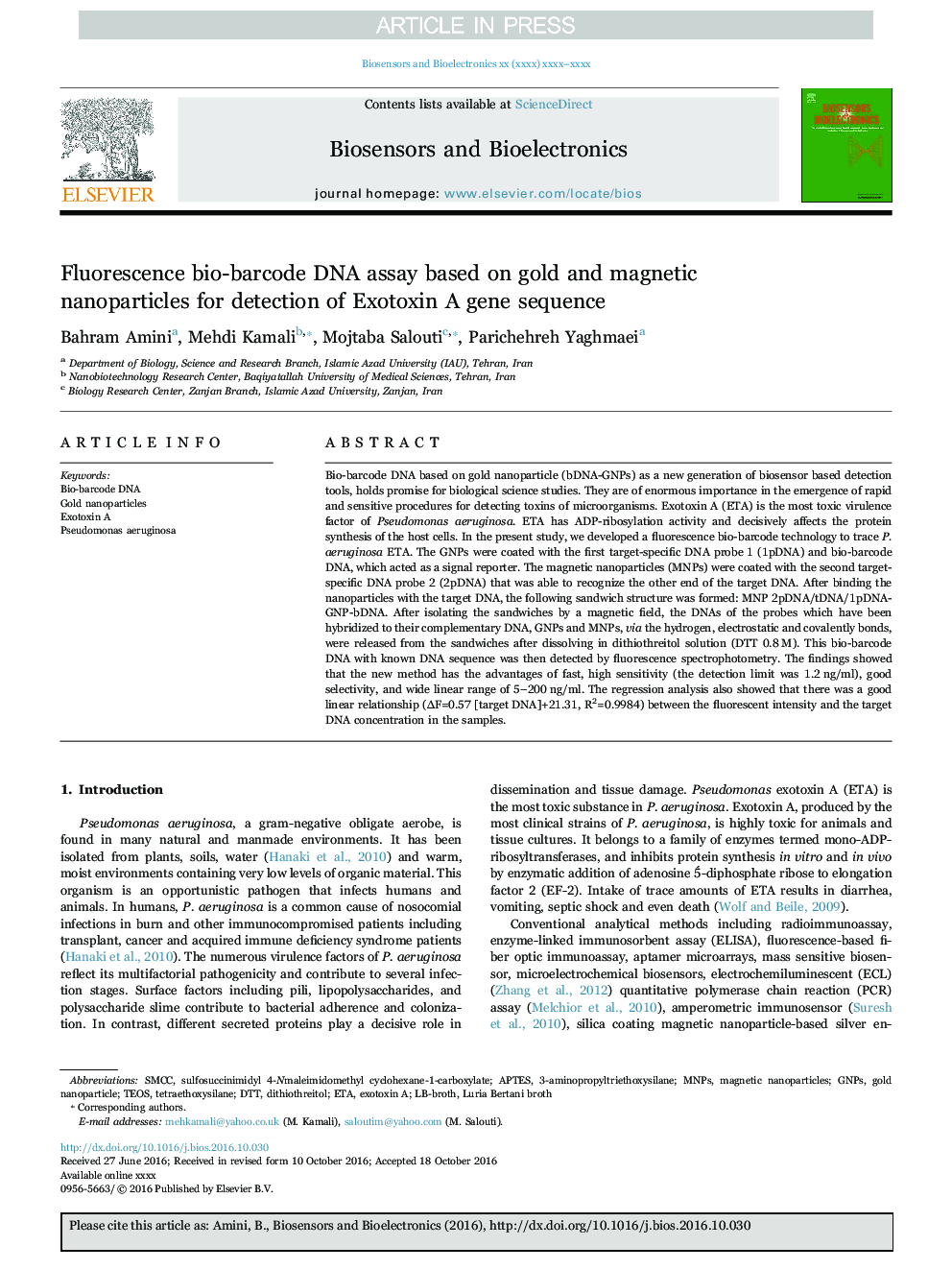| کد مقاله | کد نشریه | سال انتشار | مقاله انگلیسی | نسخه تمام متن |
|---|---|---|---|---|
| 5031654 | 1470940 | 2017 | 8 صفحه PDF | دانلود رایگان |
عنوان انگلیسی مقاله ISI
Fluorescence bio-barcode DNA assay based on gold and magnetic nanoparticles for detection of Exotoxin A gene sequence
دانلود مقاله + سفارش ترجمه
دانلود مقاله ISI انگلیسی
رایگان برای ایرانیان
کلمات کلیدی
TEOStetraethoxysilaneDTTGNPSETASMCC3-aminopropyltriethoxysilane - 3-آمینوپروپیلتریتوفاکسیلانMNPs - MNP هاExotoxin A - اگزوتوکسین Adithiothreitol - دیتیوتریتولPseudomonas aeruginosa - سودوموناس آئروژینوزاLuria Bertani broth - لوریا برتانی برودAPTES - مناسبGold nanoparticle - نانو ذرات طلاGold nanoparticles - نانوذرات طلاMagnetic nanoparticles - نانوذرات مغناطیسی
موضوعات مرتبط
مهندسی و علوم پایه
شیمی
شیمی آنالیزی یا شیمی تجزیه
پیش نمایش صفحه اول مقاله

چکیده انگلیسی
Bio-barcode DNA based on gold nanoparticle (bDNA-GNPs) as a new generation of biosensor based detection tools, holds promise for biological science studies. They are of enormous importance in the emergence of rapid and sensitive procedures for detecting toxins of microorganisms. Exotoxin A (ETA) is the most toxic virulence factor of Pseudomonas aeruginosa. ETA has ADP-ribosylation activity and decisively affects the protein synthesis of the host cells. In the present study, we developed a fluorescence bio-barcode technology to trace P. aeruginosa ETA. The GNPs were coated with the first target-specific DNA probe 1 (1pDNA) and bio-barcode DNA, which acted as a signal reporter. The magnetic nanoparticles (MNPs) were coated with the second target-specific DNA probe 2 (2pDNA) that was able to recognize the other end of the target DNA. After binding the nanoparticles with the target DNA, the following sandwich structure was formed: MNP 2pDNA/tDNA/1pDNA-GNP-bDNA. After isolating the sandwiches by a magnetic field, the DNAs of the probes which have been hybridized to their complementary DNA, GNPs and MNPs, via the hydrogen, electrostatic and covalently bonds, were released from the sandwiches after dissolving in dithiothreitol solution (DTT 0.8Â M). This bio-barcode DNA with known DNA sequence was then detected by fluorescence spectrophotometry. The findings showed that the new method has the advantages of fast, high sensitivity (the detection limit was 1.2Â ng/ml), good selectivity, and wide linear range of 5-200Â ng/ml. The regression analysis also showed that there was a good linear relationship (âF=0.57 [target DNA]+21.31, R2=0.9984) between the fluorescent intensity and the target DNA concentration in the samples.
ناشر
Database: Elsevier - ScienceDirect (ساینس دایرکت)
Journal: Biosensors and Bioelectronics - Volume 92, 15 June 2017, Pages 679-686
Journal: Biosensors and Bioelectronics - Volume 92, 15 June 2017, Pages 679-686
نویسندگان
Bahram Amini, Mehdi Kamali, Mojtaba Salouti, Parichehreh Yaghmaei,